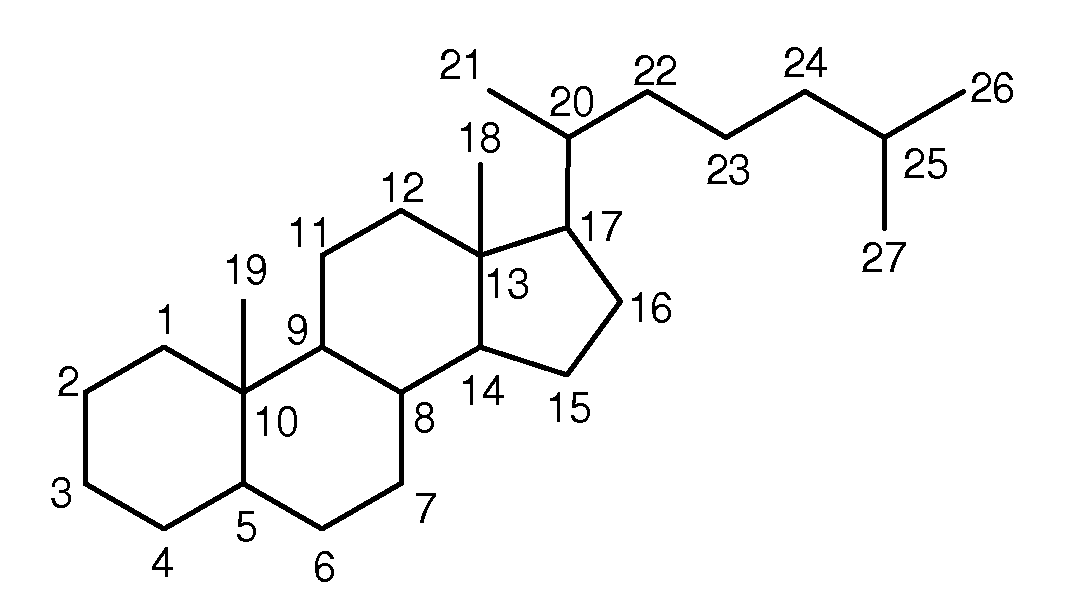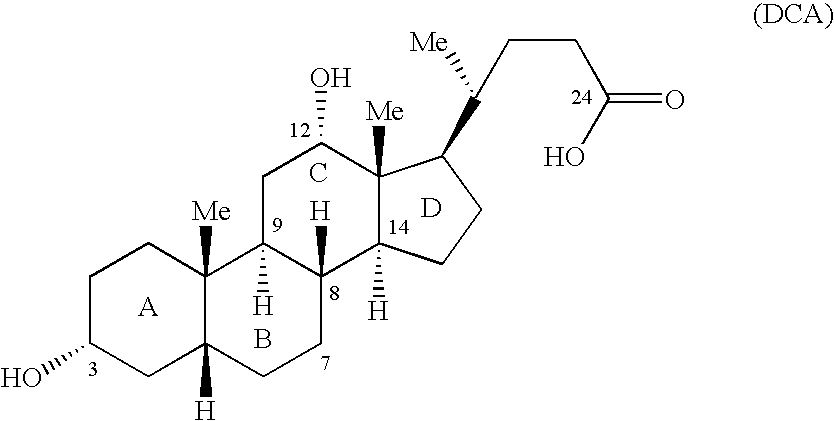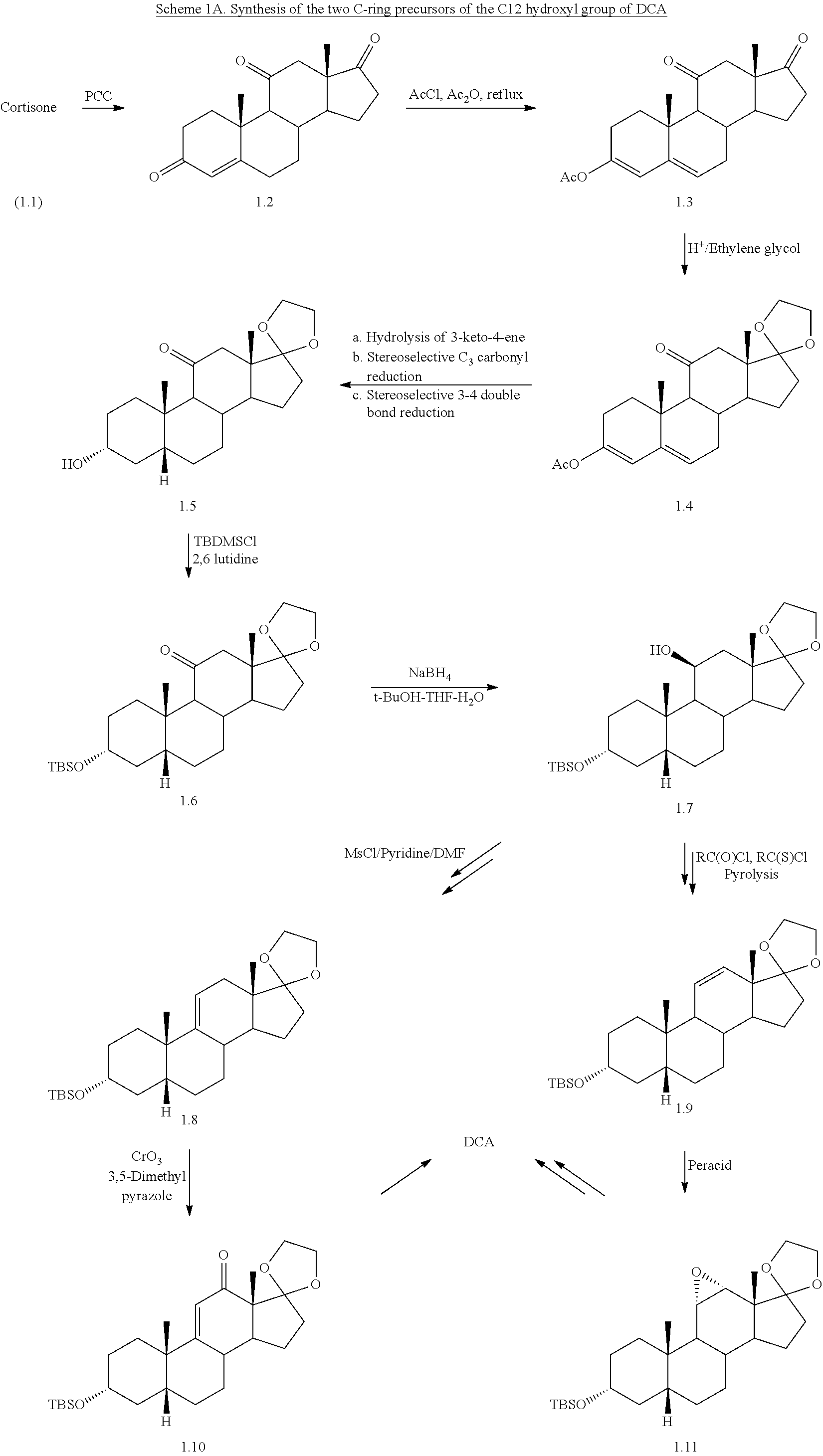Synthetic bile acid compositions and methods
a bile acid and composition technology, applied in the field of bile acids, can solve the problems of difficult risk assessment and prediction of future events pertaining to prion diseases, unable to meet the clinical needs of patients and physicians, and the safety and efficacy of these cosmetic treatments remain ambiguous to most patients and physicians, and achieve the effect of meditating body contouring
- Summary
- Abstract
- Description
- Claims
- Application Information
AI Technical Summary
Problems solved by technology
Method used
Image
Examples
example 1
Preparation of Androstane-3,11,17-trione (1.13)
[0121]10% of Pd / C (2.5 g, 5 wt %) is added to a solution of hydrocortisone (Compound 1.12) (50.0 g, 138.12 mmol) in DMF (250 mL). The resulting slurry is hydrogenated in a Parr apparatus (50 psi) for 12 h. Upon complete disappearance of starting material, as evidenced by TLC, the crude reaction mixture is filtered through a small plug of Celite, and the solvent is removed under vacuum. Crude product (48.0 g) is obtained as a colorless solid.
[0122]NaBH4 (2.1 g, 55.3 mmol) is added to a solution of the above crude product (48.0 g, 131.86 mmol) in EtOH (500 mL) and CH2Cl2 (500 mL). After 1 hr, acetone (50 mL) and water (150 mL) are added, followed by NaIO4 (70.5 g, 329.6 mmol). The mixture is stirred at room temperature overnight.
[0123]Distilled water (500 mL) is added and the mixture is extracted with ethyl acetate (3×250 mL). The ethyl acetate layer is flushed through a silica-gel plug and the solvent is evaporated to yield 38 g as a col...
example 2
3β-Hydroxy-androstane-11,17-dione (1.14)
[0127]K-Selectride® (98.39 mL, 98.01 mmol, 1M solution in THF) is added to a solution of Compound 1.13 (33.0 g, 109.27 mmol) in THF (330 mL) over 15 minutes under an inert atmosphere at −78° C. and is stirred for about 3-4 h at −78° C. The reaction mixture is quenched with aqueous NaOH solution (2M, 70 mL). The crude reaction mixture is diluted with ethyl acetate (500 mL) and the organic layer is washed with water (3×75 mL), saturated brine solution (100 mL) and dried over MgSO4 (75 g). The solvent is removed under vacuum to afford 33 g of crude material. The crude product is subjected to acetylation without purification.
Purification of Crude Material
[0128]The crude material is purified by column chromatography [29(W)×600(L) mm, 230-400 Mesh silica, 200 g], eluting with ethyl acetate / hexane (1:4) [25 mL fractions, 5 mL / min elution, monitored by TLC with p-anisaldehyde charring; Rf for Compound 1.14=0.3 and Rf for Compound 1.13=0.37 in EtOAc / He...
example 3
3β-Hydroxyandrostane-11,17-dione acetate (1.15)
[0130]Acetic anhydride (16.6 g, 162.8 mmol) is added to a solution of Compound 1.14 (33.0 g, 108.55 mmol) in pyridine (150 mL) at 0° C. under an inert atmosphere. The resulting reaction mixture is stirred overnight at ambient temperature. Upon completion of the reaction, as evidenced by TLC, pyridine and remaining acetic anhydride are removed under vacuum. The crude residue is diluted with ethyl acetate (500 mL) and washed with water (3×150 mL), saturated brine solution (100 mL) and dried over MgSO4 (75 g). The solvent is evaporated under vacuum and the crude material is purified by column chromatography [59(W)×800(L) mm, 60-120 Mesh silica, 150 g], eluting with ethyl acetate / hexane (1:10) [25 mL fractions, 10 mL / min elution, monitored by TLC with p-anisaldehyde charring; Rf for Compound 1.15=0.38 and Rf for Compound 1.14=0.1 in EtOAc / Hexane (3:7)] to afford Compound 1.15 (19.0 g, 66.4% yield) as a colorless solid. Table 4 describes the...
PUM
| Property | Measurement | Unit |
|---|---|---|
| critical micelle concentrations | aaaaa | aaaaa |
| critical micelle concentration | aaaaa | aaaaa |
| concentrations | aaaaa | aaaaa |
Abstract
Description
Claims
Application Information
 Login to View More
Login to View More - R&D
- Intellectual Property
- Life Sciences
- Materials
- Tech Scout
- Unparalleled Data Quality
- Higher Quality Content
- 60% Fewer Hallucinations
Browse by: Latest US Patents, China's latest patents, Technical Efficacy Thesaurus, Application Domain, Technology Topic, Popular Technical Reports.
© 2025 PatSnap. All rights reserved.Legal|Privacy policy|Modern Slavery Act Transparency Statement|Sitemap|About US| Contact US: help@patsnap.com



